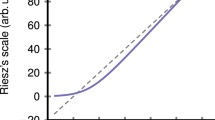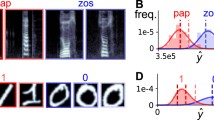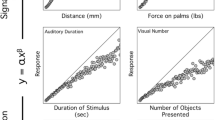Abstract
A theoretical central mechanism for the discrimination of intensities as previously developed, together with plausible assumptions concerning the receptors, are employed for the derivation of the discriminable difference between lifted weights as a function of the smaller of these weights. The function so derived depends upon three parameters, one parameter being the weight of the supporting member. Some empirical data are compared with the theoretical predictions, and a few remarks are added to describe the physiological significance of the parameters.
Similar content being viewed by others
Literature
Adrian, E. D. 1932.The mechanism of nervous action. Philadelphia: University of Pennsylvania Press.
Erlanger, Joseph and Herbert S. Gasser, 1937.Electrical Signs of nervous activity. Philadelphia: University of Pennsylvania Press.
von Frey, M. 1913. “Studien über den Kraftsinn”,Zeit. für Biol.,63, 129–54.
Holway, Alfred H. and Leo M. Hurvich, 1937. “On the discrimination of minimal differences in weight: I. A theory of differential sensitivity.”Jour. Psych.,4, 309–332.
Holway, Alfred H., Janet E. Smith and Michael J. Zigler. 1937. “On the discrimination of minimal differences in weight: II. Number of available elements as variant.”Jour. Exper. Psycho.,20, 371–380.
Holway, Alfred H. and Carroll C. Pratt. 1936. “The Weber-ratio for intensitive discrimination.”Psych. Rev.,43, 322–340.
Householder, A. S., 1939. “A neural mechanism for discrimination.”Psychometrika,4, 45–58.
Landahl, H. D., 1938. “A contribution to the mathematical biophysics of psychophysical discrimination”,Psychometrika,3, 107–125.
Landahl, H. D., 1939. “Contributions to the mathematical biophysics of the central nervous system”.Bull. Math. Biophysics,1, 95–118.
Landahl, H. D. 1940. “Discrimination between temporally separated stimuli.”Bull. Math. Biophysics,2, 00.
Matthews, Bryan H. C. 1933. “Nerve endings in mammalian muscle”.Jour. Physiol.,78, 1–53.
Oberlin, Kermit W. 1934.Sensitivity to lifted weights over a wide range of the stimulus. Harvard Ph.D. Thesis, Harvard University.
Piéron, Henri. 1933. “Les bases sensorielles de la connaissance”.Act. Sci. et Ind.,377, 7–21. Paris. Hermann et cie.
Rashevsky, N. 1938 a.Mathematical Biophysics. Chicago. The University of Chicago Press.
Rashevsky, N. 1938 b. “Contribution to the mathematical biophysics of visual perception with special reference to the theory of aesthetic values of geometrical patterns”.Psychometrika,3, 253–272.
Thurstone, L. L. 1927. “Psychophysical analysis”.Am. Jour. Psych.,38, 368–389.
Author information
Authors and Affiliations
Rights and permissions
About this article
Cite this article
Householder, A.S. A neural mechanism for discrimination: II. Discrimination of weights. Bulletin of Mathematical Biophysics 2, 1–13 (1940). https://doi.org/10.1007/BF02478027
Issue Date:
DOI: https://doi.org/10.1007/BF02478027




